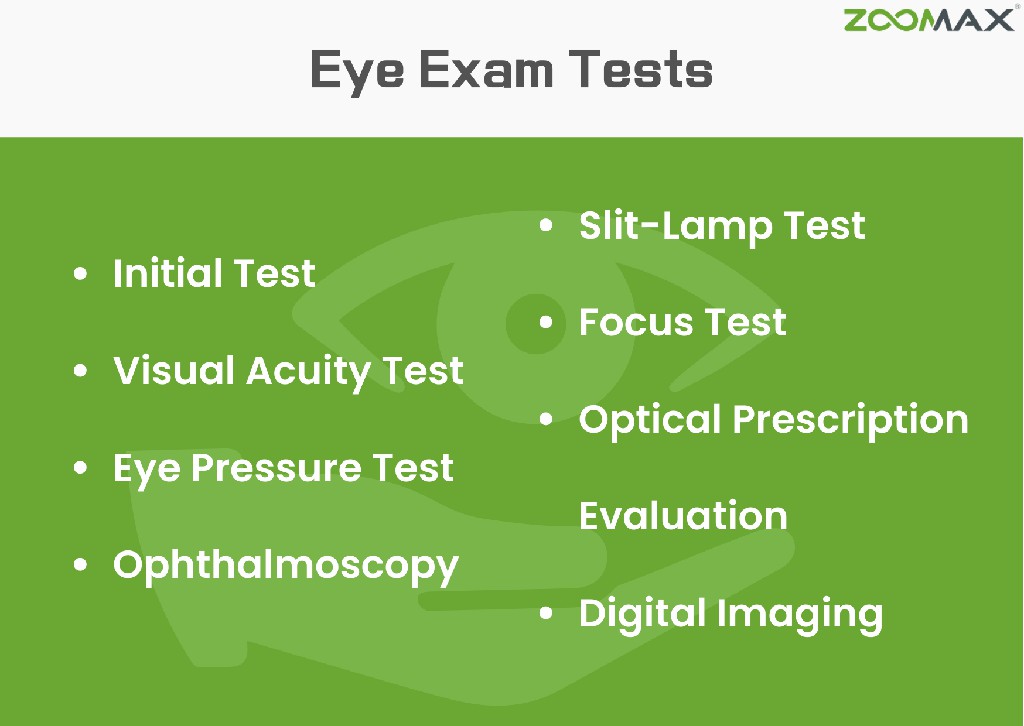While it can be something we all take for granted, eye health, like our overall health, is something we should all take responsibility for. The consequences of eyesight loss can be devastating, requiring significant changes to lifestyle and introducing new challenges. Even beyond the personal impact, a 2020 study estimated that globally, the cost of vision impairment is as much as $400 billion. It makes sense to do what you can to avoid vision health problems, and it makes sense for countries too given the cost, which is why Healthy Vision Month is here to support eye health and promote eye exams.

During Healthy Vision Month, you can enjoy a comprehensive dilated eye exam to make sure your eyesight is OK and there are no underlying issues to worry about. A great initiative that raises awareness, but why encourage eye tests? Are they really that important?
Why do we need regular Eye Exams?
Regular eye exams are great for maintaining eye health, as they can spot issues early and help you get the treatment you need as soon as possible. This can make all the difference when dealing with common eye diseases, ensuring your vision health over time.
 Access to eye exams is something we do take for granted, which is why a reminder like Healthy Vision Month is so useful, but it is not like this everywhere. Large areas of South Asia and sub-Saharan Africa have rates of eye diseases leading to blindness as high as eight times more than the average, and even higher than many European countries. Yet more than 50% of those are preventable eye problems, with the main barrier to that prevention being the prevalence of eye exams worldwide.
Access to eye exams is something we do take for granted, which is why a reminder like Healthy Vision Month is so useful, but it is not like this everywhere. Large areas of South Asia and sub-Saharan Africa have rates of eye diseases leading to blindness as high as eight times more than the average, and even higher than many European countries. Yet more than 50% of those are preventable eye problems, with the main barrier to that prevention being the prevalence of eye exams worldwide.
In total, there are over a billion people that have suffered from vision impairment because they lack access to even basic eye health care such as a regular eye test. While organizations such as the World Health Organization highlight the cost to economies of that in an effort to persuade governments to invest in preventative measures, those figures represent a massive effect on human life, each one a tragedy that could be avoided. We mentioned earlier the cost of over $400 billion, yet the WHO also suggests that providing eye exams and access to vision health services for these regions could be as little as $25 billion.
With regular eye exams, a number of common eye diseases can be identified early, preventing eyesight loss and the challenges of 20/200 vision. These include:
- Age-related macular degeneration
- Cataracts
- Diabetic retinopathy
- Glaucoma
 In all cases, spotting the problem quickly can drastically change the impact, with studies showing that over 50% of cases of visual impairment could have been prevented with early treatment. That is why it is so important to have regular eye tests, but there are other reasons too. For those who wear visual aids, glasses or contacts for instance, an eye test can also ensure that you have the right corrective lenses. The thing many people misunderstand is that it is not a once-and-done thing, your eye health changes over time, and the type or correction required can too.
In all cases, spotting the problem quickly can drastically change the impact, with studies showing that over 50% of cases of visual impairment could have been prevented with early treatment. That is why it is so important to have regular eye tests, but there are other reasons too. For those who wear visual aids, glasses or contacts for instance, an eye test can also ensure that you have the right corrective lenses. The thing many people misunderstand is that it is not a once-and-done thing, your eye health changes over time, and the type or correction required can too.
With the wrong corrective lenses causing issues, whether with your vision itself or in other ways, such as headaches or other side effects, it is crucial that your corrective lenses are adjusted as required, and a regular eye exam is the best way to do that.
How do Eye Exams Work?
Eye exams cover a range of tests and visual inspection of the eyes but are not invasive and are not something to worry about. Many people avoid eye tests because they are nervous, often thinking that eye tests are a difficult process. However, an eye test is simple and easy, using minimal equipment and requiring no invasive procedures at all.
Your vision is both important and delicate, and as a result, eye exams will include a number of different tests to examine the various aspects of the eye and surrounding area, so that the doctor can get a good indicator of your vision health. These tests vary depending on your particular medical situation, but usually include:
- Initial Test – Here your overall eyesight will be evaluated, with checks of your peripheral vision, depth perception, color vision and eye movement, along with checking how your pupils react to light sources. This is carried out manually by the ophthalmologist.
- Visual Acuity Test – Used to evaluate the clarity of vision with each eye. This is carried out using a reading chart with the decreasing size of text that we are all familiar with.
- Eye Pressure Test – A puff of air is directed at the eye, and is used to diagnose eye issues such as glaucoma or corneal disease.
- Ophthalmoscopy – Using a bright light, this test examines the back of the eye, looking for cataracts, glaucoma, retinal detachment and degeneration.
- Slit-Lamp Test – This provides a magnified view of the eye and allows the eye doctor to check for signs of problems, infections and so on.
- Focus Test – Checks not just eye focus, but mobility as well, ensuring both eyes have a full range of movement so work well as a pair.
- Optical Prescription Evaluation – If you already use glasses or contacts, your eyesight will be evaluated with this eye test to see if any changes are necessary to improve vision clarity.
- Digital Imaging – In some cases, the eye doctor may take a digital image of the retina of one or both eyes so they can have a closer look at anything previous tests may have revealed. These highly detailed photographs are used for accurate diagnosis, and also form a historical record of each eye to track any potential deterioration in visual health.

In all cases, the eye doctor will talk you through what is happening beforehand, but as mentioned none of these eye exams are invasive. It is a simple process that you can fit into your day and will not interrupt your schedule at all.
Healthy Vision Month
Doing regular eye exam is the very initial way to maintain healthy vision. Those with higher risk, such as someone suffering from diabetes, may want to have more frequent eye tests than others for instance. However, organizations such as the UK National Health Service and the CDC along with various Health Insurers such as Aetna recommend every 2 years for low-risk patients, increasing to an annual test for those over 55 or high risk of visual problems.
 In addition to regular eye exams, developing a healthy lifestyle is a method to keep good vision as well. For instance, eating a balanced diet and doing exercises on a regular basis are the measures that we’ve mentioned many times. Fresh fruit and green leafy vegetables are the food that acquires abundant nutrition which can benefit our vision. Seafood can also be a good option as they are rich in omega-3, which is the key element that can work for good eyes. To know more right foods for the eyes, please check: Do You Choose the Right Foods for Your Eyes? or get specific recipes to contribute to your eyes: Cook Your Thanksgiving Healthy Food to Feed Your Eyes.
In addition to regular eye exams, developing a healthy lifestyle is a method to keep good vision as well. For instance, eating a balanced diet and doing exercises on a regular basis are the measures that we’ve mentioned many times. Fresh fruit and green leafy vegetables are the food that acquires abundant nutrition which can benefit our vision. Seafood can also be a good option as they are rich in omega-3, which is the key element that can work for good eyes. To know more right foods for the eyes, please check: Do You Choose the Right Foods for Your Eyes? or get specific recipes to contribute to your eyes: Cook Your Thanksgiving Healthy Food to Feed Your Eyes.
Meanwhile, doing exercises on a regular basis doesn’t mean you have to go to the gym every day or keep exercising for a long time. In fact, there are many types of workouts that are gentle and suitable for almost everyone. Both young and old people can find a moderate movement that they can be satisfied with. Check New Year, Let Us Keep Healthy – Exercises for the Low Vision to see more exercise options. Also, if you are interested in more ways to keep your vision healthy, a checklist for healthy vision might be helpful: Save Your Vision: Checklist for Eye Health.
Healthy Vision Month is a very welcome reminder of the importance of eye tests, and how they can transform visual health outcomes through early diagnosis and treatment. The meaning of Healthy Vision Month is to aware us how to maintain healthy vision, emphasize the importance of eye health, and realize the purpose of healthy eyes. With healthy eyes and good vision, we are able to have more vocational choices, we can attend more social activities, and have more interesting interactions with our families and friends. These shall be the underlying connotations that Healthy Vision Month is trying to convey.
It is vital that everyone makes full use of the tests available to help maintain visual health and deal with problems before they become something more. Healthy Vision Month is a wonderful campaign and one we wholeheartedly support, and we urge everyone to get regular eye tests to help them stay healthy.
References
https://www.cdc.gov/visionhealth/resources/features/eye-health-my-health.html
https://www.who.int/news/item/08-10-2019-who-launches-first-world-report-on-vision
https://www.thelancet.com/journals/langlo/article/PIIS2214-109X(20)30488-5/fulltext
https://www.iapb.org/learn/vision-atlas/about/downloads/#snapshots
https://www.aetna.com/health-guide/2020-vision-still-need-eye-exam.html
https://www.cdc.gov/visionhealth/resources/features/keep-eye-on-vision-health.html
https://www.news-medical.net/health/Importance-of-Regular-Eye-Checks-Procedure.aspx
https://www.cdc.gov/visionhealth/healthyvisionmonth/index.htm

